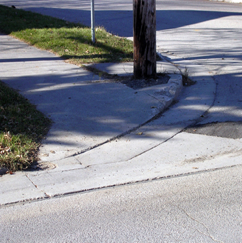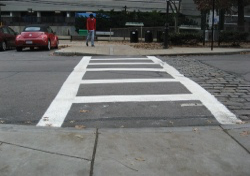The other day as I was out shopping a woman fell just outside of a department store. The step out front of the store was barely painted, and the store did very little to come to her aid. In conversation with an employee, she admitted that this isn’t the first time an older adult fell outside of their store, on the same step, and that they often drive away without seeking medical attention.
As for the woman, numerous passerby came to her aid, but she was noticeably (and rightfully) in a bit of shock from the event and although numerous attempts were made to have her seek help she ultimately got into her car and drove away.
Neglecting to incorporate age-friendly design can have a domino effect on the life of our older adults.
Still, days later, I can’t help but think how this situation could have been avoided.
If we created our public spaces with the older adults needs in mind, this woman could have gone home only to worry about the beautiful blouse she neglected to buy. Instead, her independence was called into question as she stood there alone surrounded by so many strangers she murmured, “I will call my children to help.”
Falls have an emotionally scarring impact on all of us. After a tumble, we become more careful and timid while walking or during our regular routines. Although I can’t speak for this women, it is feasible that she will avoid shopping at this store…not for lack of interest in the products but rather out of fear she could fall again.
And let’s face it, falling as an older adult is much different than falling at any other age.
Yes, injuries can be much more severe and recovery time can be much longer but maybe even worse than the physical injuries themselves is the sudden ever cautious and watchful eyes of our loved ones. After a fall, statements like “be careful” when mentioning going out to the store, or, “Are you sure? Why don’t you let me do that for you instead” become a part of each conversation.
Age-friendly designs in the community
Efficiently designing for older adults requires design thinking because it is crucial that thinking, empathy, and emotion are incorporated into the design. An efficient design will allow an older adult to continue to age independently and make them feel safe and secure in their surroundings.
Making the transition to an age-friendly community can be a process. However, there are relatively small-scale design features a community can implement to get the innovation process started. In the figures below, there are photographs of how small design fixes can offer big improvements.
Sidewalk Ramps
The first picture below depicts a sidewalk ramp slightly elevated from the street. The slight elevation creates a physical constraint for someone in a wheelchair or walking with a walker. As ramps allow us to regain access to the sidewalk, it becomes essential that bumps are removed so that wheelchairs and walkers can move smoothly back onto the sidewalk.

The next picture demonstrates a level ramp between street and sidewalk. A smooth ramp provides users with much easier accessibility to the sidewalk and will allow someone to move quickly out of the busy street.

Crosswalks
The picture below shows a faded crosswalk at a busy intersection. The crosswalk is barely visible to drivers and pedestrians alike. A crosswalk is a symbol for the driver to slow down and to allow pedestrians to cross; however, if it is faded and indistinguishable to a driver, it no longer demonstrates a relationship between pedestrians crossing and need to slow down.

Older adults depend on crosswalks to know when and where they can safely cross the street. Faded walks not only confuse drivers but can also be difficult for seniors attempting to pass.
The picture below, however, is good for both pedestrian and driver. The visible lines allow both parties to distinguish the space as a crosswalk, which provides feedback to the driver to slow down for the pedestrians who are crossing. And the best part is, it only takes a little paint!

When we create homes and communities with the older adult in mind, we are simulating an experience for all community members to not only be conscious of the needs of the older adult but also to show that with just a few adjustments, older adults can continue to live independently and contribute to their neighborhoods.
Image Sources:
International Federation on Aging Global Communities. (2013, April). Retrieved August 2016, from http://www.ifa-fiv.org/enews/april-2013/
Brookline Community Aging Network. (n.d.). Brookline Can. Retrieved August 6, 2016, from Pedestrian-friendly sidewalks and crossings: http://www.brooklinecan.org/livable_community.html

This article resonates with me in at least two ways. I am a senior citizen who has fallen in public places due to thoughtless designs as well as at home due to my own carelessness. I also have a younger sister who is stricken with MS, and has been confined to a wheelchair for 30 years. Consequently, I tend to notice badly designed ramps, curb cuts, handrails, etc.
I often wonder if these designs would be the same if the people in charge of implementing them had loved ones who were being affected.
I believe those of us who are aware of the problem should voice our concerns to the various authorities who have the ability to effect the needed changes. I don’t mean complain about the problem, but shed light on it, and on the fact that it will only grow worse as the “Boomer” generation ages. A little forethought now could make a world of difference to future generations.
Thank you for your caring articles.
LikeLike
Hi Joni, thank you for your comment! I couldn’t agree more. Building our communities so that they are accessible for all is so important. Thank you for sharing your experience – awareness is the first step! Sincerely, Molly
LikeLike